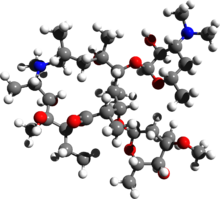Azithromycin
 |
|
 |
|
| Clinical data | |
|---|---|
| Trade names | Zithromax, Azithrocin, others |
| AHFS/Drugs.com | Monograph |
| MedlinePlus | a697037 |
| License data |
|
| Pregnancy category |
|
| Routes of administration |
(capsule, tablet or suspension), intravenous, ophthalmic |
| ATC code | |
| Legal status | |
| Legal status |
|
| Pharmacokinetic data | |
| Bioavailability | 38% for 250 mg capsules |
| Metabolism | Hepatic |
| Biological half-life |
11–14 h (single dose) 68 h (multiple dosing) |
| Excretion | Biliary, renal (4.5%) |
| Identifiers | |
|
|
| Synonyms | 9-deoxy-9α-aza-9α-methyl-9α-homoerythromycin A |
| CAS Number | |
| PubChem CID | |
| IUPHAR/BPS | |
| DrugBank | |
| ChemSpider | |
| UNII | |
| KEGG | |
| ChEBI | |
| ChEMBL | |
| NIAID ChemDB | |
| ECHA InfoCard | 100.126.551 |
| Chemical and physical data | |
| Formula | C38H72N2O12 |
| Molar mass | 748.984 g·mol−1 |
| 3D model (Jmol) | |
|
|
|
|
11–14 h (single dose)
Azithromycin is an antibiotic useful for the treatment of a number of bacterial infections. This includes middle ear infections, strep throat, pneumonia, traveler's diarrhea, and certain other intestinal infections. It may also be used for a number of sexually transmitted infections including chlamydia and gonorrhea infections. Along with other medications, it may also be used for malaria. It can be taken by mouth or intravenously with doses once per day.
Common side effects include nausea, vomiting, diarrhea and upset stomach. An allergic reaction or a type of diarrhea caused by Clostridium difficile is possible. No harm has been found with its use during pregnancy. Its safety during breastfeeding is not confirmed, but it is likely safe. Azithromycin is an azalide, a type of macrolide antibiotic. It works by decreasing the production of protein, thus stopping bacterial growth.
Azithromycin was first made in 1980. It is on the World Health Organization's List of Essential Medicines, the most effective and safe medicines needed in a health system. It is available as a generic medication and is sold under many trade names worldwide. The wholesale cost in the developing world is about 0.18 to 2.98 USD per dose. In the United States it is about 33 USD for a course of treatment.
...
Wikipedia
